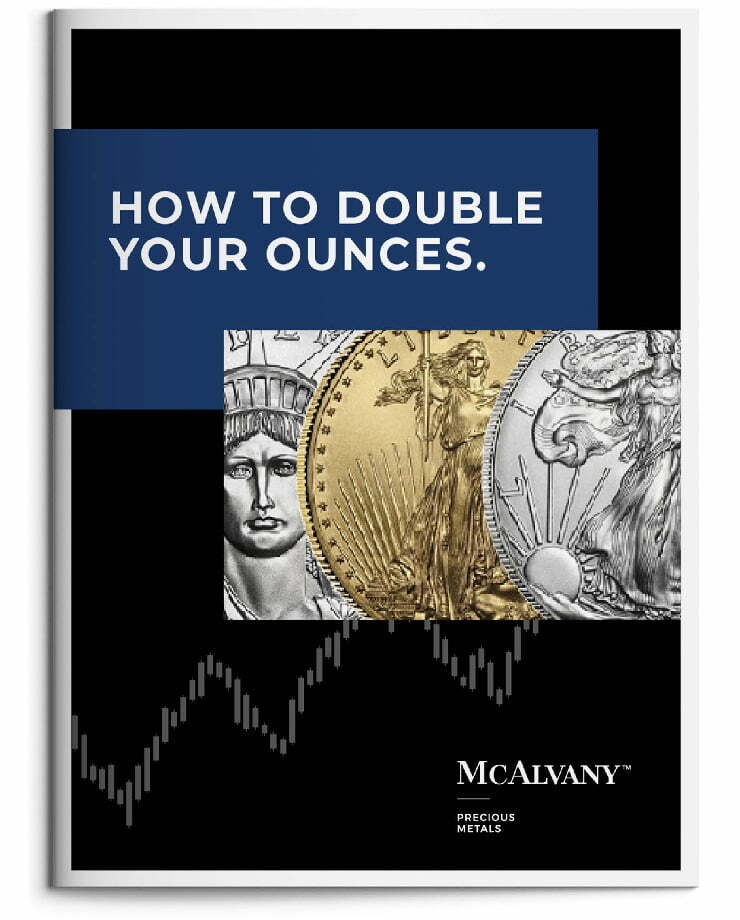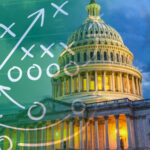The “New” That Awaits
For months, HAI has been increasingly confident that a break away from the post-1971 global financial/monetary system is the goal of Trump administration policy. The administration seems to believe that incentivizing a fundamental redirection of global capital flows can weaken the dollar, balance trade, and ultimately revitalize the U.S. manufacturing sector. Fixing the proverbial “American factory” serves both an economic and a national security fix, and it appears this attempted manufacturing fix is the means by which Trump intends to MAGA.
Now, redirecting the typical global capital flows of recent decades is no small undertaking. It may ultimately have the benefit of helping to revitalize U.S. manufacturing, but it will come with near-term consequences as well. Weakening the dollar and balancing trade will shrink the trade deficit, and those trade deficits have been recycled on a global scale back into U.S. financial assets for decades. Shrink the trade deficit, and you shrink or even outright reverse the foreign dollar recycling flows back into U.S. financial assets that have, in large part, facilitated a bubble in U.S. Treasuries and stocks. In other words, Trump’s MAGA agenda, whether it ultimately works or not, may well be the pin that pops the great financial asset bubble of our time.
Last week, HAI offered crucial evidence that this reversal of global capital flows may, in fact, have already begun. Amid fresh data of very large outflows from U.S. assets by foreign private sector investors, along with evidence of the fastest pace of U.S. equity selling ever seen from the foreign official sector, HAI quoted Charles Schwab’s Liz Ann Sonders’ warning that, “we may be seeing the early stages of a tectonic shift in global investment flows” leading to a “dramatic decline in demand for U.S. assets from abroad.”
The point is, those outflows alone already put the U.S. financial asset bubble in a most precarious place. But in this holiday shortened market trading week, some important economic data added to HAI‘s broad market concerns. The recent data suggests that, in addition to the structurally negative impact of foreign capital outflows, U.S. markets must now also grapple with a U.S. economy that may be in the process of seizing up. The profound uncertainty of incredibly impactful and rapidly changing tariff policy, other as yet unknown economic policy initiatives, and the resulting negative shocks to supply chains are now all beginning to show in the data.
The suddenly negative economic environment caused by extreme policy uncertainty, economic growth uncertainty, and uncertainty over rising costs now facing the corporate machine was well described this week by Scott Lincicome, Vice President of General Economics and Trade Policy at the Cato Institute. As Lincicome put it, “It’s a brutal environment for folks who want to spend billions of dollars on a 30-year project.” Lincicome continued, “Even when you think you’re playing by the rules…the rules might change tomorrow and you’re going to get hit again.” In short, the remarkable economic uncertainty is causing businesses to sit on their hands and wait for clarity, and while they wait, the economy appears to be slipping.
On a lag, the increasing signs of incoming economic weakness are mounting. The latest Federal Reserve Bank of New York survey data reveals that consumer expectations for higher levels of unemployment have now surged in 2025 to the highest levels since Covid lockdowns.
Citibank’s earnings revisions index just had its worst week of negative corporate earnings revisions in what is now a very notable 17-week streak of negative earnings revisions. Worse yet, that collapse in earnings expectations was corroborated this week by the latest BofA Fund Manager Survey data. It showed the U.S. corporate profit outlook is now viewed as the most unfavorable environment for profits since November of 2007—one month before the Great Recession hit.
In another alarming economic sign, the Philadelphia Fed’s manufacturing survey just had its fourth worst monthly drop ever. After the Philly Fed’s regional manufacturing activity diffusion index for general activity scored a positive 12.5 reading in March, the April data plummeted to a negative 26.4 (a negative reading indicating contraction) versus expectations for a positive 2.0 reading. The only months in survey data history with larger drawdowns were two months during Covid lockdowns and October 2008—during the heart of the Great Financial Crisis.
In short, the combined dual threat of both structural capital outflows and a wobbling U.S. economy now seem to represent two pins each taking aim at the asset bubble balloon at the same time.
Now, HAI hasn’t discussed the U.S. Federal Reserve and its ability to come riding to the rescue of markets and the economy very much at all lately. That’s mostly because, in HAI‘s view, the Fed is already largely trapped and sidelined with nowhere to run on policy.
At the moment, Fed policy optionality appears handcuffed by three primary complicating and conflicting factors. First, the U.S. economy has until very recently appeared (at least on the surface of lagging data, as measured by non-farm payrolls, jobless claims, and GDP) to be strong enough to not need further rate cuts. Second, inflation remains meaningfully above the Fed’s 2% target and, embarrassingly, has been stuck above target since the early spring of 2021 (a fact arguing for rate hikes). Third, the U.S. government has a massive debt problem that could accelerate into a full-blown debt spiral if the Fed doesn’t cut rates at the front end of the curve and perhaps suppress yields (by hook or by crook) on the long end. So again, in HAI‘s view, the Fed is trapped in a damned if you do, damned if you don’t quagmire.
That said, now that markets have turned volatile and President Trump’s tariffs have increased the risk of serious stagflationary consequences, members of the Fed have suddenly become quite chatty. This week, Fed Chair Powell acknowledged the stagflationary threat of a noxious cocktail of both rising prices and slowing economic growth. Powell said, “We may find ourselves in the challenging scenario in which our dual-mandate goals are in tension. If that were to occur, we would consider how far the economy is from each goal and the potentially different time horizons over which those respective gaps would be anticipated to close.” He added, however, that “For the time being, we are well positioned to wait for greater clarity before considering any adjustments to our policy stance.”
Now, while Powell’s “wait for greater clarity” position seems to be the party line for most Fed members at the moment, HAI strongly suspects that comments this week from Fed governors Susan Collins and Christopher Waller point more directly to where Fed policy will rapidly be heading.
According to the Financial Times, Susan Collins, head of the Boston Fed, said this week that the central bank “would absolutely be prepared” to deploy its firepower to stabilize financial markets should conditions become disorderly. Collins affirmed that the Fed has had to deploy various tools very quickly in the past to address chaotic conditions in markets and the economy, and that now, similarly, the Fed “would absolutely be prepared to do that as needed.”
Even more to the point, Fed governor Christopher Waller said, “With [the scenario of] a rapidly slowing economy, even if inflation is running well above 2%, I expect the risk of recession would outweigh the risk of escalating inflation, especially if the effects of tariffs in raising inflation are expected to be short lived.”
That is exactly what HAI expects from the Fed as well—upcoming market and economic weakness to be allowed to reach a crisis point before that crisis is ultimately used as cover for a hefty inflationary policy response into already elevated levels of inflation. And to be clear, in HAI‘s view, if the U.S. is going to be reshoring it’s manufacturing base, the inflationary impact will almost certainly not be short lived. Rather, the inflationary impulse (turbocharged by the Fed’s stimulative helping hand) is very likely to be strong and long-term (secular) in nature.
So, what does it all mean? In HAI‘s view, a base case for expectations at this point is this: structural capital outflows from U.S. assets and a slowing economy along with rising price pressures will all boil over until the Fed, in crisis response mode, hits the inflationary policy response button.
That means that unless Trump and company wilt on tariffs and give up the MAGA dream, be on the alert for a renewed bout of equity market weakness in the not-too-distant future. Assuming the Fed does meet the moment with a forceful inflationary policy response, then expect gold, silver, and the precious metals mining stocks to truly rocket launch.
This week, we received important confirmation that the structural capital outflows from U.S. financial assets discussed earlier are already disproportionately finding a new home in gold. In an article titled, “China Offers Banks Extra Gold Import Quotas as Investors Flock,” Bloomberg reported that “The People’s Bank of China has allocated fresh gold import quotas for some commercial banks…as Beijing responds to strong haven demand from institutional and retail investors in the face of an escalating trade war.” According to Bloomberg, “The additional quotas were allocated last week to meet significantly increased [gold] appetite.”
In fact, in a foreshadowing of the destination of redirected global capital flows to come, according to John Reade of the World Gold Council, “Chinese gold ETFs have seen more gold inflows in the first 11 days of April than in the whole of 2025.” In other words, as Trump and company pursue their MAGA goal and begin to impose trade barriers intended to redirect global capital flows, we are already seeing smoking gun evidence that the dollar recycling of old is rapidly transitioning to a new era of gold recycling as the monetary metal resumes its historical role as primary global reserve asset over U.S. financial assets.
Now, as Ray Dalio says, “He who lives by the crystal ball will eat shattered glass.” So, no crystal balls here. But, in HAI‘s best assessment, if the Fed eventually issues an inflationary policy response to a weakening U.S. economy and slumping markets, the reinvigorated western investor appetite for gold will dramatically amplify already accelerating international gold recycling dynamics to kick-off what HAI believes will be the ultimate upside yellow metal price rerating gold bugs have been waiting decades for. In HAI‘s view, at this point, “bugs” likely don’t have to wait long—and they ain’t seen nothing yet.
Week after week, the case for an imminent golden era continues to strengthen and verify. While the future is—as ever—unknown, in HAI‘s view the best bet is that all roads now lead to gold.
Whether or not Trump succeeds in his apparent MAGA goal to reinvigorate U.S. manufacturing is yet to be determined. But importantly, HAI believes that his attempt alone will almost certainly end the post-1971 global financial/monetary system as we’ve known it. With that said, the end of the old is also the beginning of something new. And in this case, good old gold looks to feature most prominently in the “new” that awaits.
Weekly performance: The S&P 500 was off 1.50%. Gold gained 2.77%, silver was higher by 0.75%, platinum was up 2.83%, and palladium was gained 6.29%. The HUI gold miners index added 2.41%. The IFRA iShares US Infrastructure ETF was up 1.50%. Energy commodities were volatile and mixed on the week. WTI crude oil was up 5.17%, while natural gas was off 8.36%. The CRB Commodity Index was up 2.05%. Copper was up 3.52%. The Dow Jones US Specialty Real Estate Investment Trust Index gained 3.60%. The Vanguard Utilities ETF was up 1.99%. The dollar index was off 0.53% to close the week at 99.23. The yield on the 10-yr U.S. Treasury was down 16 bps to close at 4.33%.
Have a wonderful weekend!
Best Regards,
Morgan Lewis
Investment Strategist & Co-Portfolio Manager
MWM LLC















